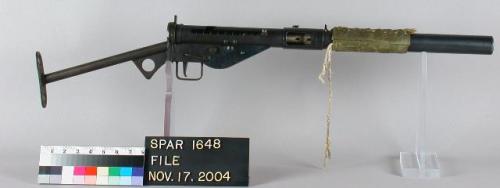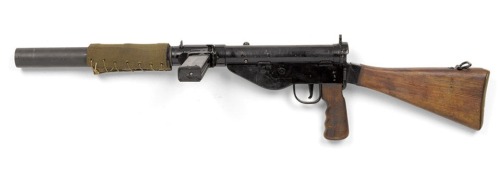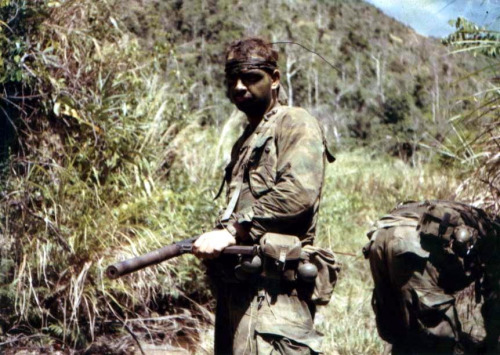

Silenced STENs
The first suppressed STEN was built following a request from the Special Operations Executive (SOE) for a submachine gun which could be used for clandestine missions where increased firepower was needed. Early experiments with suppressing the Thompson (favoured by British Commandos early in the war) proved to be a failure. The Royal Small Arms Factory took the STEN MkII and incorporated an integral suppressor - one of the first weapon of its kinds to do this. It was officially designated the designated ‘Carbine, m/c Sten, 9mm Mk2(S)’. While it is widely believed that the ’S’ stands for silenced or suppressed it actually meant ‘Special Purpose’.
The MkII(S)’s barrel was ported and surrounded by a jacket filled with baffles to expand and dissipate the propellant gasses. To ensure reliable cycling the weapon’s bolt was lightened and several coils were removed from the recoil spring. The suppressor lowered the weapon’s muzzle velocity from around 365 m/s down to 300 m/s - well below the speed of sound. With sustained or repeated firing it was found that the ported barrel and suppressor heated up rapidly. This was combated by issuing a canvas barrel cover to insulate the user’s hand. Sustained full auto fire of just one magazine would effectively wear out the baffles and burn out the suppressor. The first operational MkII(s) was used in Europe in 1943 by members of the SOE, it also saw action in the far east and with special reconnaissance parties.

MkII(S), not the canvas jacket cover, held by Springfield Armory (source)
There seems to have also been a silenced STEN based on the aborted MkIV prototypes - the Mk IVA(S). This, however, along with the standard MkIV STEN was never adopted and the more robust, better made MkV was adopted instead. With the operational success of the MkII suppressed STEN a version of the refined MkV STEN was developed in 1944 as the MkVI(S). It used the stock furniture and receiver of the MkV but included the same canvas insulating shroud developed for the MkII(S). The MkVI’s suppressor was shorter than the earlier MkII(S)’s but was more difficult to disassemble and service.

STEN MkVI(S) (source)
The silenced STENs were extremely effective and while they could not be fired in fully automatic beyond short bursts, if fire was kept to single or two round bursts then the weapon avoided serious overheating and fatigue.
Otto Skorzeny, an SS officer who took part in the Mussolini rescue operation in 1943, went to great lengths to acquire a suppressed STEN. When he finally obtained one he noted: ‘What splendid possibilities the use of these silencers offered, I thought enthusiastically. What losses they might save and what dangers they might avert! How wonderful, in case of an unexpected meeting with an enemy detachment, to be able to fire without the reports attracting the attention of other enemy groups!’ The Germans captured a number of MkII(S) during the war and designated them the MP 751(e).

Member of a LRRP holds a suppressed STEN, Vietnam. (source)
While the MkII(S) was officially declared obsolete by the British Army in April 1945, it remained in service for several decades. A total of 5,776 MkII(S) and 24,824 MkVI(S) were made during the war. The British army continued using them during the counterinsurgency operations in Malaya and Kenya during the 1960s. The MkII(S) and MkVI(S) STENs remained in British military service until the early 1970s. A suppressed version of the Sterling submachine gun, the L34A1, was developed to replace the suppressed STENs in 1966 and for many years served along side the STENs with special forces units such as the SAS and SBS.

Sterling L34A1 (source)
They also remained in service into the 1960s with the Australian SAS using both the MkII(S) and MkVI in Vietnam. US units of MACV SOG (Military Assistance Command Vietnam, Special Operations Group) also favoured suppressed STENs for clandestine operations such as long range reconnaissance, prisoner snatches and assassinations. The MkII(S) was well liked because it could be disassembled easily and stored compactly in a rucksack. This allowed operators to also carry a primary weapon. The British Army’s special forces would continue to use the suppressed STENs well into the late 1970s, replacing it with suppressed MP5s in the 1980s. The suppressed STENs were widely regarded as one of the most efficient silenced submachine guns of the era seeing service for over 30 years.
Sources:
Silencers, Snipers & Assassins: An Overview of Whispering Death, J.D. Truby (1972)
The STEN Gun, L. Thompson (2012)
Modern Small Arms, F. Myatt (1978)
If you enjoy the content please consider supporting Historical Firearms through Patreon!
melancholywalker liked this
 cmortongm liked this
cmortongm liked this el-mas-feu liked this
djangoft liked this
 manoginklai reblogged this from awp101
manoginklai reblogged this from awp101 sancheeeeez762 reblogged this from historicalfirearms
cormallen reblogged this from dieselpunkflimflam
 happynowber-blog liked this
happynowber-blog liked this  tje524 liked this
tje524 liked this reportnob liked this
wherethevideogames reblogged this from horribleham and added:
@yakuiblazeserryday @reportnob
thingsjpsays liked this
horribleham reblogged this from officialmugi
en-garde-fuccboi reblogged this from officialmugi
en-garde-fuccboi liked this
officialmugi reblogged this from moontouched-moogle
thelazyflip liked this
pitchers-0-stuff liked this
funisanawfulthing liked this
awp101 reblogged this from historicalfirearms
 kylemhurich liked this
kylemhurich liked this remotecontrolchuck liked this
 jim11756 liked this
jim11756 liked this  ashddhgwvevevevsve-blog reblogged this from historicalfirearms
ashddhgwvevevevsve-blog reblogged this from historicalfirearms  ashddhgwvevevevsve-blog liked this
ashddhgwvevevevsve-blog liked this ravenbloom-haven reblogged this from bolt-carrier-assembly
ravenbloom-haven liked this
lspcastle reblogged this from dieselpunkflimflam
 kalashboyz liked this
kalashboyz liked this church-of-idgaf liked this
 rednines liked this
rednines liked this historicalfirearms posted this
- Show more notes
